790 Duke test: KTM takes on the bestselling roadsters

KTM currently dominates the segment of "maxisportifs" maxiroadsters in France, thanks to its 1290 Super Duke R. In 2018, the Austrian brand is entering the court of medium-capacity roadsters with this brand new 790 Duke… So, success in sight? Test !
790 Duke test page 3: Technical point
Engine
A revolution. To tackle the best "maxi-mid-size" roadsters on the market, KTM has designed its first parallel twin: the LC8c, for "liquid cooling, 8-valve, compact". The Mattighofen firm makes infidelities to the V-twins that equip its large engines and aligns (hohoho) on the competition.
KTM has been forced to recognize that this architecture "offers the best compromise in terms of compactness and finesse". More powerful and usable than a large single-cylinder, shorter and lighter than a V-twin of the same displacement, the parallel twin is the solution, used on small Z and MT.

The mechanical Orange is distinguished by its very particular setting at 75 °, in order to resemble the large LC8s open at 75 °, precisely. Remember that Kawasaki has opted for a 180 ° setting on the "twin midsize" and Yamaha for a 270 ° setting on its .
The crankcase features nikasil-treated aluminum cylinders that do not need a jacket. Inside, two forged pistons with three rings, a smooth big end bearing and a DLC (Diamond-Like Carbon) coated piston pin. These 88mm diameter pancakes come and go on 65.7mm.
At 9000 roundtrip / min, the 799 cc twin develops a maximum power of 105 hp. The maximum torque of 86 Nm is reached 1000 rpm lower. A little light to go teasing Z900, MT-09 or Street Triple? KTM replied in the negative, recalling that the 790 Duke is precisely less heavy than its rivals. We will come back…

"As these cylinders are of the" open deck "type, they guarantee optimal engine cooling and allow a wider range of production tolerances", detail the Austrian engineers. Lubrication is provided by a semi-dry sump and the oil is cooled by "a system similar to that used on large LC8 engines".
The "water" mill has two overhead camshafts – "cast, lighter than forged camshafts", says KTM – which actuate eight steel valves and are driven by a tension-controlled timing chain. by a hydraulic tensioner.
Two balance shafts are responsible for minimizing engine vibrations: the first is placed in front of the crankshaft and the second higher, inside the cylinder head, between the two camshafts. Unfortunately, MNC was able to observe that the vibrations appear in the mid-range and increase to the red zone..
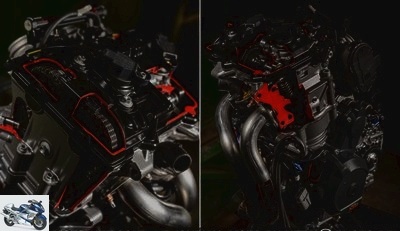
The clutch benefits from an anti-slipping device, coupled with electronic throttle management (ride-by-wire) which prevents any slippage of the rear wheel. However, the super-bikers and stunters can rest assured: the Katoche allows you to deactivate the electronic crutches and make good crossings under braking !
Necessarily "Ready to Race", the KTM receives as standard a quickshiter "+" which allows to do without the left lever to the rise as to the descent of the reports. "The rider keeps the handlebars firmly in hand," says KTM. It also shifts its gears faster and is less likely to disturb the balance of the motorcycle..
Finally, the Austrian brand has planned a limited version at 70 kW of this brand new engine, in order to open up to the new A2 licenses. They will have to drive two years on their 790 Duke "L" half portion 35 kW, before taking advantage of its 95 horsepower (and not 105, as on the "full" version).
Cycle part
According to KTM, "the design of the bike has clearly been focused on purity". The 790 Duke is inspired by the looks and technical choices of its predecessors – the charismatic 1290 Super Duke R in the first place, but also the medium and small 690-390-125 Duke -, but traces its own path.
Thus the frame (s) rests largely on the engine, whose "carrier" function allows the size and weight of the tubular chromium-molybdenum trellis to be reduced as much as possible. "It’s a little wonder welded by robot and laser cut, with a superb exterior finish", congratulates the builder. !
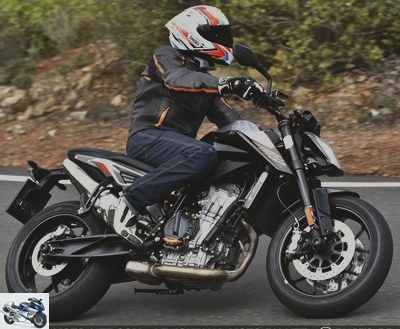
Trademark of KTM road motorcycles ("on-road"), the aluminum boxed swingarm shows its ridged concave part. The engineers went to the most basic by connecting it directly to its WP shock absorber: "Its manufacture requires fewer parts and is much simpler". Cheaper, lighter … but effective !
At the front too, savings are in order: the WP inverted fork – "naturlich" – 43 mm "offers unusual operation in this segment," says Katoche. "The whole point of this type of fork with separate damping circuits (compression on the left and rebound on the right, not adjustable, editor’s note) is to allow finer tuning of the behavior".
Another original feature of the 790’s front axle: "the cleverly designed triple trees and handlebar mounts allow four different handlebar positions". The handlebars can also be swiveled to three different positions.
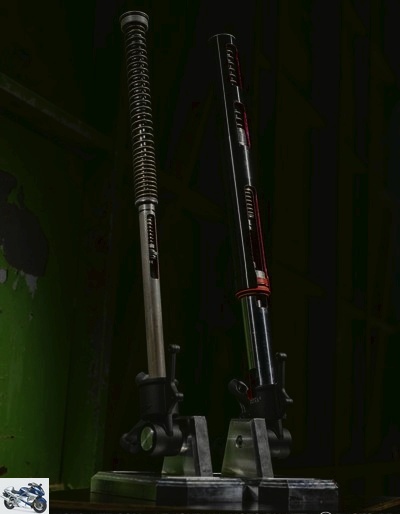
The 760 mm wide handlebars must not suddenly and involuntarily swing by swarming on the road or by attacking on the circuit: a steering damper is responsible for "providing maximum feeling to the rider, preserving the agility of the motorcycle and to increase security ". Phew !
The "extremely" light alloy rims accommodate original tires from a brand unknown to the general public – even bikers! – but renowned among enduro riders and mountain bikers, very committed to Supermotard: Maxxis, whose Supermaxx ST rubber would have been specially developed for the new KaTe…
"These tires provide excellent grip on both dry and wet surfaces and are suitable for both sport and everyday use. The sporty character of these tires is ideal for the KTM 790 Duke. Known for their high resistance to wear, they give a very good stability to the motorcycle ", guarantees the manufacturer. Real Swiss knives for the Austrian "Scalpel" !
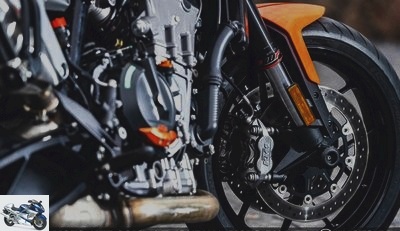
Braking is entrusted to a pair of 300 mm discs bitten by monobloc radial-mounted four-piston calipers, via a radial master cylinder, also, "Danke Schon" … At the rear, a disc of 250mm is clamped by a two piston caliper.
"We have done a lot of work with our supplier (the Spanish J. Juan, and not the Italian Brembo or its Indian subsidiary ByBre, editor’s note), especially at the level of the pads, in order to find the desired feeling", assure the Austrians.
Finally, the 790 Duke adopts a one-piece aluminum buckle that cleverly houses the airbox. Without plastoc covering or clad support, it helps to lighten the machine: 169 kg dry on the Mattighofen scale !
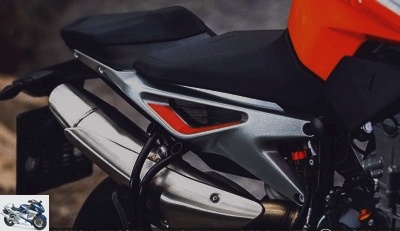
"Are we going to use the same type of loop on future Super Duke? It is not obvious because the V configuration of the engine does not allow us to integrate the airbox in the same way", replies Luke Brackenburry. , KTM press manager. "And given the health of the LC8, weight is less of a concern …"
Maneuvering the 790 Duke is all the easier if its saddle is not too high (825 mm). As an option, however, the smallest bikers can buy a saddle low to 805 mm. If necessary, they can even install a lowering kit for the chassis.
Electronic
Always at the forefront of electronics, KTM ensures that its main novelty for 2018 is "a model of ingenuity". Like its big and big sisters, the 790 Duke notably receives traction control and finely managed ABS.
The traction control, which ensures that the speed of rotation of the rear wheel is never "disproportionate to the driving situation", is sensitive to the angle of inclination of the motorcycle thanks to the sensor which informs them. longitudinal, lateral and vertical acceleration, as well as attitude and roll. Only the lace is missing !
"In a few thousandths of a second, the MTC reduces engine power via the throttles smoothly and almost imperceptibly, until the system has reduced slip to a level consistent with the selected drive mode and angle of inclination reached ", describes the Austrian brand.
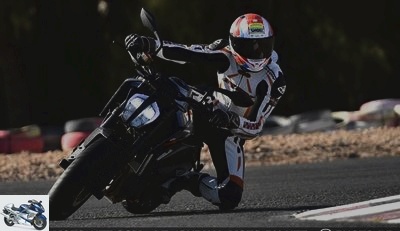
Mandatory in Europe, the ABS of the 790 Duke also takes into account the inclination of the motorcycle. Thanks to MSC assistance and its Bosch 9.1MP modulator which manages the pressure in the braking circuit, "you do not risk destabilizing your bike in the bends, even by fully pressing the brakes" guarantees Katoche. Chick ?!
In the same “Heading or no heading” series, KTM allows the rider to deactivate the ABS, at the rear only, in order to let him tackle the bends in “Supermoto” mode. Similarly, the MTC can be unplugged: "for daredevils, we have provided an" off-switch ", an off button", Katoche tries..
When braking, the MSR function ensures that the rear wheel does not lock up during too sudden a downshift or when the grip is too precarious for the "ex-cel-slow" tires … "The ride system by-wire opens the throttle just enough to guarantee controlled deceleration ", KTM predicts.
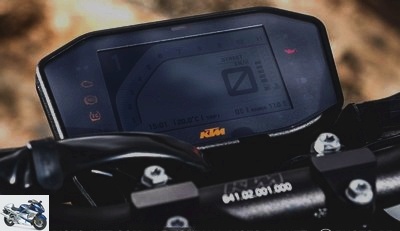
To simplify the task of its pilot, the Duke integrates four driving modes: a "Rain" very careful to ride in the rain or on wet and wet, a "Street" a little less wise, a "Sport" even more fun which "allows a respectable level of drift and a noticeable amount of skidding" and a customizable "Track".
In this fourth "circuit" mode, the pilot can engage Launch Control, deactivate the anti-wheeling sub-function, select himself the degree of reactivity of the throttle grip (Street, Sport or Track) and the level of intervention of the throttle. traction control (9 levels and off). Once chosen, the parameters obviously remain in memory.
All the necessary – and superfluous – settings and information are displayed on the color TFT dashboard: "when you rev up, the bars on the screen change color and prompt you to accelerate or warn you if the engine is still cold". You got it, bro ?!
Finally, the screen automatically adapts its brightness to the ambient light – but can’t fight the sun behind your back! – and zaps to a specific "race" display when "Track" mode is selected.
Related articles
-
790 Duke test: KTM takes on the bestselling roadsters KTM currently dominates the segment of maxisportifs maxiroadsters in France, thanks to its 1290…
-
790 Duke test: KTM takes on the bestselling roadsters KTM currently dominates the segment of maxisportifs maxiroadsters in France, thanks to its 1290…
-
KTM 390 Duke test: the A2 license with class and without restraint The KTM 390 Duke launched in 2013 evolves at the same time as its little sister 125,…
-
Z900RS test: the new neo-retro Kawasaki Zed, zen and zealous Kawasaki is back in the neo-retro segment with a brand new motorcycle: the Z900RS! Site was…
-
Roadster – Yamaha MT-09 SP test: the one we SPEED! – MT-09 SP test page 3: Technical point
Yamaha MT-09 SP test: the one we Sought ! The Yamaha MT-09, one of the stars of the French motorcycle market, never ceases to enchant bikers eager for…
-
F900R test: the completely revised BMW roadster … with a dejà vu R BMW has just presented two major 2020 novelties to the international press: the…
-
All Tests – KTM 1290 Super Duke GT Test: Ready to Track! – Super Duke GT: MNC technical point
KTM 1290 Super Duke GT test: ready to track ! Adding a windshield and a semi -fairing to a roadster to develop road skills, the idea is not new. But when…
-
Test 125 Duke: big update for the small KTM At the beginning of the 10s (2010 …), KTM had revitalized the 125 cc motorcycle sector by releasing the…
-
Roadster – Test Yamaha MT-09 2017: mult (r) iples pleasures! – Page 3 – Technical point MT-09 2017
2017 Yamaha MT-09 review: mult (r) iples pleasures ! Having become a bestseller in just four years, the Yamaha MT-09 is full of positive developments for…
-
2019 Katana test: new fit for the Suzuki maxiroadster Suzuki is making a daring bet on the roadster segment in 2019 by launching a new Katana. A…